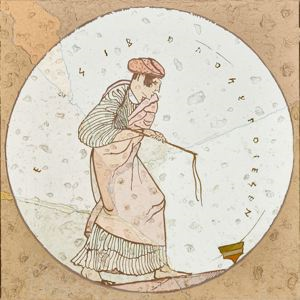| Showing 1 of 1 |
|
Jess Collins (aka Jess)
American
(1923–2004)
Spinning Off the Top of It:Translation #30
1975
Oil on board
20.75 x 20.75 x 1.5 in.
Gift of the Marie Eccles Caine Foundation
2005.5
The Translations, Jess’s series of paintings depicting found images, were begun in 1959, after he had the idea of creating a complex painting on the myth of Narcissus, classical mythology’s embodiment of self-reflection and image obsession. Daunted by the prospect of incorporating a vast number of figurative elements within a single work, Jess decided first to embark on a project that would teach him more about the craft of figurative art. The result was a group of paintings based on photographs, prints, and drawings, rendered in the manner of schematically outlined and colored paint-by-number canvases.
Over the next seventeen years, as the series grew to include thirty-two pieces, it became less a learning tool than a multifaceted demonstration of Jess’s evolving aesthetic. In reworking the black-and-white source images, he employed an odd abstract expressionist palette, giving the paintings a color scheme that doesn’t necessarily coincide with their subjects. Jess correlated each found image with a pertinent text—from Plato, William Blake, Gertrude Stein, and others—that he inscribed on the back of the canvas. Elaborating on his deep involvement with the project, he stated: “I wanted to make myself aware of what I felt about this image. And this intense meditative process that I had undertaken allowed those feelings to come forth.”
Demonstrating his fascination with the circuitous history of mythic images, in Translation #29 Jess appropriates a woodcut illustration found in Pagan Mysteries in the Renaissance, by art historian Edgar Wind. The image came from a Renaissance edition of a fifth-century text by an Egyptian priest, Horapollos, that inventoried the meaning of hieroglyphics. The depicted emblem represents a divine eye floating above a landscape that features a classical obelisk and aqueduct in ruins. The Latin text translates as “This is the way of god.” Originating in legends about the eye of Horus—the Egyptian sky god—the divine eye is a recurring icon, even featured on the US dollar bill, placed at the apex of a pyramid, symbolizing the nation’s providential stability. On the back of the painting, Jess transcribed a quotation from The Vision of God by fifteenth-century German philosopher Nicholas of Cusa that relates God’s overseeing vision to personal self-reflection, a crucial theme for Jess and a primary thesis of
the Translations.
A sense of play both grounds and elevates Jess’s work. In Translation #30 he meticulously copies a black-and-white drawing of the interior of an ancient Greek drinking cup that features a priest of Bacchus involved in the ritualistic spinning of a top. The top was a symbol of the passage of time and the movements of celestial bodies. This conflation of a children’s game and an ancient religious ritual was an ideal subject for Jess’s investigation of mythic transformation.
Michael Duncan
Click a term to view the records with the same keyword
- beige - A variable color generally light grayish-yellowish brown, originally referring to the color of unbleached wool.
- human
- light blue
- man
- Uses of the Real I , 1/20/2008 - 4/30/2011
- Uses of the Real Part II , 7/1/2009 - 8/30/2010
- Independent & Creative Impulse: Dialogues from the Collection , 8/16/2011 - 5/9/2014
- Enchanted Modernities: Mysticism, Landscape, and the American West , 4/16/2014 - 12/11/2014
- Collecting on the Edge , 9/15/2018 - 5/4/2019
- Collecting on the Edge Part II Nora Eccles Harrison Museum of Art , 1/17/2019 - 5/4/2019
This object is a member of the following portfolios:
Your current search criteria is: Keyword is "CKS" and [Objects]Artist is "Jess Collins".



